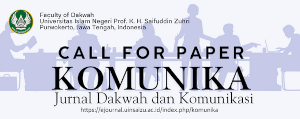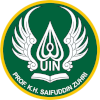THE METHOD OF HYPNO-CIRCUMCISION IN KLINIK KHITAN PLUS HYPNOSIS IN PABUWARAN PURWOKERTO UTARA SUBDISTRICT
DOI:
https://doi.org/10.24090/komunika.v10i2.948Keywords:
Method, Hypno-Circumcision, Klinik Khitan Plus Hypnosis.Abstract
This research explains the method of hypno-circumcision in the clinic. Generally, the service of circumcision still uses a conventional method and less of attention toward the psychological side. Whereas, this factor is very important on how affecting the patients view’s toward circumcision. The main goal of this research is to know the implementation of hypnosis in medical field, especially circumcision process in Klinik Khitan Plus Hypnosis Pabuwaran.The method used in this research is descriptive-analysis. This method is used to provide an overview of the method of hypno-circumcision in Klinik Khitan Plus Hypnosis. This research found that method of hypno-circumcision in Klinik Khitan Plus Hypnosis is similar with hypnosis in general. The method of hypno-circumcision into four stages: preparation stage, induction stage, suggestion stage and termination stage. Preparation of hypno-circumcision in Klinik Khitan Plus Hypnosis begins from consultation to Ms. Novi as receptionist. Then, Induction is a main way to bring someone from conscious to subconscious mind. Giving suggestion is the core stage in the process of hypno-circumcision. Last stage is termination which defines as a gradual step to bring the subject to consciousness.Downloads
Download data is not yet available.
References
Almiatin, Isma MD. (2010). Dahsyatnya Hypnosis Learning, untuk Guru dan Orang Tua, Hipnosis untuk Pembelajaran di Sekolah dan Pengasuhan Anak di Rumah. Yogyakarta: Pustaka Widyatama.
Anam, Saiful. (2010). 4 Jam Pintar Hipnosis, dari Mengenal Istilah, Konsep, Tahapan, Teknik, Sugesti, hingga Panduan Praktik Hipnosis. Jakarta: Visimedia.
Arif, Antonius. (2011). The Handbook of Hypno Therapy, Scripts and Strategies. Jakarta: Gramedia.
Arikunto, Suharsimi. (2002). Prosedur Penelitian Suatu Pendekatan Praktek, Yogyakarta: Rineka Cipta.
Azwar, Saifuddin. (1998). Metodologi Penelitian. Yogyakarta: Pustaka Pelajar.
Bayne, Tim.â€Hypnosis and the Unity of Consciousnessâ€, University of Oxford and St. Catherine’s College. United Kingdom (tim.bayne @gmail.com). This paper was published in (2007) Hypnosis and Conscious States, ed. Graham Jamieson (ed.), Oxford: Oxford University Press (93-109). Accessed on Monday, Mei 20th 2013, at 01.00 p.m.
Foley, Kathleen. MD, “Dismantling the Barriers: Providing Palliative and Pain Careâ€, Cornell University Medical College, New York, NY, at http://jama.ama-assn.org/cgi/content/full/283/1/118.(Accessed on Monday, Mei 20th 2013, at 01.00 p.m.).
Giles,C. Scot. “A Method for using Hypnotism with Persons Living with Cancer, Essay, 2004. Accessed on Monday, Mei 20th 2013, at 01.00 p.m.
Goldman, R, The psychological impact of circumcision, BJU International (1999), 83, Suppl. 1, 93–102, Circumcision Resource Center, Boston, Massachusetts, USA (http://onlinelibrary.wiley.com/doi/10. pdf, accessed on Tuesday, July 23th 2013 at 15.09 p.m.)
Hakim, Andri. (2011). Hypnosis in Teaching, Cara Dahsyat Mendidik dan Mengajar, Jakarta: Visimedia.
Hypnosis&hypnotherapy scripts, Australia’s Hypnosis Online, at www.hypnosisonline.com.au. Accessed on Wednesday, July 3rt 2013 at 11.00 a.m.
Khairah, Fastabiqul. “Khitan: Bagi Laki-laki dan Perempuan,†http:// 4moslem.wordpress.com/2008/11/16/khitan-bagi-laki-laki-danperempuan, Accessed on Tuesday, July 23th 2013 at 03.09 p.m. Moleong, Lexy J. (2008). Metodologi Penelitian Kualitatif. Bandung: Rosdakarya.
Muafif. (2007). Pelaksanaan Psikoterapi Islam Terhadap Psikosis (Studi Kasus Pondok Pesantren Asy-Syamsiyah Desa Sawangan Kecamatan Alian Kabupaten Kebumen. Thesis, STAIN Purwokerto.
Mustofa, Agus. (2011). Energi Dzikir, Alam Bawah Sadar. Surabaya: Padma Press.
Peynovska, Rumy Dr Jackie Fisher, Dr David Oliver, Prof V.M. Mathew, “Efficacy of Hypnotherapy as a Supplement Therapy in Cancer Interventionâ€, European Journal of Clinical Hypnosis: 2005 volume 6 - issue 1, Accessed on Monday, Mei 20th 2013, at 13.00 p.m.
Ruslan, Rosady. (2004). Metode Penelitian, Public Relations dan Komunikasi. Jakarta: PT Raja Grafindo.
Shicida, Makoto. (2010). The Mistery of The Right Brain, Mengungkap Misteri Otak Kanan untuk Membuat Anak Jadi Jenius. Terj. Femi Olivia. Jakarta: Gramedia.
Suryabrata, Sumadi. (2011). Metodologi Penelitian. Jakarta: PT Raja Grafindo.
Setiawan Budi Utomo. (2003). Fiqih Aktual Jawaban Tuntas Masalah Kontemporer. Jakarta: Gema Insani.
Tanzeh, Ahmad. (2011). Metodologi Penelitian Praktis. Yogyakarta: Terras. Trismiati. “Perbedaan Tingkat Kecemasan Antara Pria dan Wanita Akseptor Kontrasepsi Mantap di RSUP Dr. Sardjito Yogyakartaâ€, Journal of Psychology in Faculty of Psychology, University of Gadjah Mada.
Wong, Willy and Andrew Hakim. (2009). Dahsyatnya Hypnosis. Yogyakarta: Visimedia.
Yuniarti, Ade. (2012). “Method of Hypnotherapy The Winner Instituteâ€, Thesis. STAIN Purwokerto.
wikipedia.org/wiki. Accessed on Monday, Mei 21th 2013, at 01.00 p.m.
www.mestrohipnotis.com.Accessed on Monday, Mei 20th 2013, at 01.00 p.m.
www.psychologytoday.com, Accessed on Tuesday, July 23th 2013 at 03.09 p.m.
www.asch.net. Accessed on thuesday, June 25th 2013, at 19.31 p.m.
www.indramajid.com, “Mengenal Hipnotis Modern.†Accessed on thuesday, June 25th 2013, at 19.31 p.m.
www.brightfuture.org. Accessed on thuesday, June 25th 2013, at 19.31 p.m.
Anam, Saiful. (2010). 4 Jam Pintar Hipnosis, dari Mengenal Istilah, Konsep, Tahapan, Teknik, Sugesti, hingga Panduan Praktik Hipnosis. Jakarta: Visimedia.
Arif, Antonius. (2011). The Handbook of Hypno Therapy, Scripts and Strategies. Jakarta: Gramedia.
Arikunto, Suharsimi. (2002). Prosedur Penelitian Suatu Pendekatan Praktek, Yogyakarta: Rineka Cipta.
Azwar, Saifuddin. (1998). Metodologi Penelitian. Yogyakarta: Pustaka Pelajar.
Bayne, Tim.â€Hypnosis and the Unity of Consciousnessâ€, University of Oxford and St. Catherine’s College. United Kingdom (tim.bayne @gmail.com). This paper was published in (2007) Hypnosis and Conscious States, ed. Graham Jamieson (ed.), Oxford: Oxford University Press (93-109). Accessed on Monday, Mei 20th 2013, at 01.00 p.m.
Foley, Kathleen. MD, “Dismantling the Barriers: Providing Palliative and Pain Careâ€, Cornell University Medical College, New York, NY, at http://jama.ama-assn.org/cgi/content/full/283/1/118.(Accessed on Monday, Mei 20th 2013, at 01.00 p.m.).
Giles,C. Scot. “A Method for using Hypnotism with Persons Living with Cancer, Essay, 2004. Accessed on Monday, Mei 20th 2013, at 01.00 p.m.
Goldman, R, The psychological impact of circumcision, BJU International (1999), 83, Suppl. 1, 93–102, Circumcision Resource Center, Boston, Massachusetts, USA (http://onlinelibrary.wiley.com/doi/10. pdf, accessed on Tuesday, July 23th 2013 at 15.09 p.m.)
Hakim, Andri. (2011). Hypnosis in Teaching, Cara Dahsyat Mendidik dan Mengajar, Jakarta: Visimedia.
Hypnosis&hypnotherapy scripts, Australia’s Hypnosis Online, at www.hypnosisonline.com.au. Accessed on Wednesday, July 3rt 2013 at 11.00 a.m.
Khairah, Fastabiqul. “Khitan: Bagi Laki-laki dan Perempuan,†http:// 4moslem.wordpress.com/2008/11/16/khitan-bagi-laki-laki-danperempuan, Accessed on Tuesday, July 23th 2013 at 03.09 p.m. Moleong, Lexy J. (2008). Metodologi Penelitian Kualitatif. Bandung: Rosdakarya.
Muafif. (2007). Pelaksanaan Psikoterapi Islam Terhadap Psikosis (Studi Kasus Pondok Pesantren Asy-Syamsiyah Desa Sawangan Kecamatan Alian Kabupaten Kebumen. Thesis, STAIN Purwokerto.
Mustofa, Agus. (2011). Energi Dzikir, Alam Bawah Sadar. Surabaya: Padma Press.
Peynovska, Rumy Dr Jackie Fisher, Dr David Oliver, Prof V.M. Mathew, “Efficacy of Hypnotherapy as a Supplement Therapy in Cancer Interventionâ€, European Journal of Clinical Hypnosis: 2005 volume 6 - issue 1, Accessed on Monday, Mei 20th 2013, at 13.00 p.m.
Ruslan, Rosady. (2004). Metode Penelitian, Public Relations dan Komunikasi. Jakarta: PT Raja Grafindo.
Shicida, Makoto. (2010). The Mistery of The Right Brain, Mengungkap Misteri Otak Kanan untuk Membuat Anak Jadi Jenius. Terj. Femi Olivia. Jakarta: Gramedia.
Suryabrata, Sumadi. (2011). Metodologi Penelitian. Jakarta: PT Raja Grafindo.
Setiawan Budi Utomo. (2003). Fiqih Aktual Jawaban Tuntas Masalah Kontemporer. Jakarta: Gema Insani.
Tanzeh, Ahmad. (2011). Metodologi Penelitian Praktis. Yogyakarta: Terras. Trismiati. “Perbedaan Tingkat Kecemasan Antara Pria dan Wanita Akseptor Kontrasepsi Mantap di RSUP Dr. Sardjito Yogyakartaâ€, Journal of Psychology in Faculty of Psychology, University of Gadjah Mada.
Wong, Willy and Andrew Hakim. (2009). Dahsyatnya Hypnosis. Yogyakarta: Visimedia.
Yuniarti, Ade. (2012). “Method of Hypnotherapy The Winner Instituteâ€, Thesis. STAIN Purwokerto.
wikipedia.org/wiki. Accessed on Monday, Mei 21th 2013, at 01.00 p.m.
www.mestrohipnotis.com.Accessed on Monday, Mei 20th 2013, at 01.00 p.m.
www.psychologytoday.com, Accessed on Tuesday, July 23th 2013 at 03.09 p.m.
www.asch.net. Accessed on thuesday, June 25th 2013, at 19.31 p.m.
www.indramajid.com, “Mengenal Hipnotis Modern.†Accessed on thuesday, June 25th 2013, at 19.31 p.m.
www.brightfuture.org. Accessed on thuesday, June 25th 2013, at 19.31 p.m.
Downloads
Issue
Section
Articles
License
Authors who publish with this journal agree to the following terms:
- Authors retain copyright and grant the journal right of first publication with the work simultaneously licensed under a Creative Commons Attribution-ShareAlike 4.0 International License that allows others to share the work with an acknowledgement of the work's authorship and initial publication in this journal.
- Authors are able to enter into separate, additional contractual arrangements for the non-exclusive distribution of the journal's published version of the work (e.g., post it to an institutional repository or publish it in a book), with an acknowledgement of its initial publication in this journal.
- Authors are permitted and encouraged to post their work online (e.g., in institutional repositories or on their website) prior to and during the submission process, as it can lead to productive exchanges, as well as earlier and greater citation of published work (See The Effect of Open Access).

























